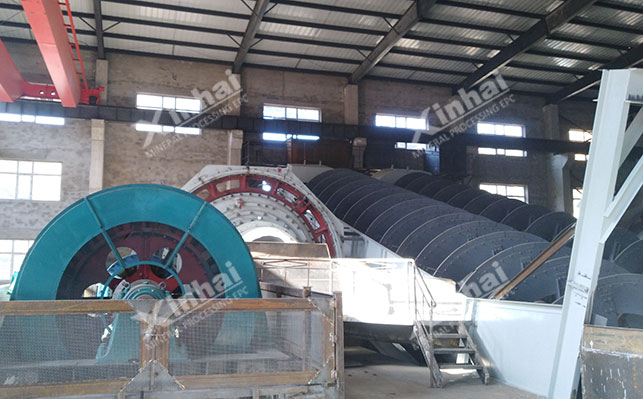Lead-zinc slag and nickel-iron slag are solid waste residues generated during the smelting of lead-zinc ore. These solid smelting slags usually contain iron and lead. In these solid waste residues, iron-lead symbiotic particles need to be separated. Zinc slag can be divided into dry slag and wet slag. Currently, the process mainly involves wet slag, where iron-lead symbiotic particles and zinc slag are encapsulated in solid waste residue. To separate iron-lead symbiotic particles, zinc slag must be crushed and ground to break the symbiotic structure between iron-lead particles and the waste residue, allowing individual dissociation of iron-lead particles from the ground zinc slag and waste residue.
A simple crushing process can partially dissociate some waste residue and iron-silver symbiotic particles, but there are still materials that are difficult to dissociate, and the material contains lumps with a particle size above 5mm. To improve the dissociation of materials, grinding is usually required. Using grinding equipment will not cause damage to the equipment due to the presence of large particles. Therefore, grinding equipment plays a crucial role in the entire process. We know that common grinding equipment includes ball mills and rod mills. So, which one should be chosen for grinding zinc slag?

According to the nature of different zinc slag, ball mills or rod mills can be selected for grinding. Using a ball mill for grinding can effectively break the continuous structure between iron-lead alloy particles and waste residue, contributing to a good effect on the next separation.
Advantages of the ball mill include:
(1) High Grinding Efficiency
The grinding efficiency of the ball mill is higher than that of the rod mill. It can quickly grind the ore or ore powder to the required particle size. This is because the ball mill uses collisions and friction between the balls to crush and grind the ore, providing higher energy density and grinding efficiency.
(2) Automated Control
The automation of the ball mill's control system is crucial for achieving efficient and stable production. By using devices such as programmable logic controllers (PLCs) or industrial computers (IPCs), the automation control of the ball mill can be realized. Automation of the control system can achieve precise control of various parameters, such as grinding time, water addition, ball-to-material ratio, etc., thereby improving grinding efficiency.
In addition, in monitoring, batching, water and air supply, and data processing, the ball mill has also achieved automation control.
The advantage of the rod mill lies in its large processing capacity, high grinding efficiency, and the use of peripheral discharge to solve the problem of clearing the grinding equipment. However, the grinding efficiency is lower than that of the ball mill.
Advantages of the rod mill include:
(1) Power Savings
It saves more than 40% of power compared to old-fashioned crushing equipment. The product granularity is relatively uniform. The product granularity characteristics curve of the rod mill working in open circuit is almost the same as that of the ball mill working in closed circuit.
(2) Adjustable Particle Size
The discharge particle size can be changed by simple adjustment, and it has a built-in fineness control device. The discharge can be equipped with a screening device, ensuring that no over-grinding or unqualified products enter the finished product. The particle size characteristics of the rod mill product are related to the crushing situation of the rod mill. When the rod hits the ore, it first breaks the coarse grains and then grinds the smaller ore particles, thereby reducing the risk of over-crushing.
When the rod rises along the lining plate, it carries coarse grains like a rod sieve, allowing fine particles to pass through the gaps between the rods. This is beneficial for crushing coarse grains and concentrating coarse grains at the location where the grinding medium impacts. Therefore, the product of the rod mill is relatively uniform, and over-crushing is lighter.
In summary, we have introduced the advantages of ball mills and rod mills in the process of handling zinc slag. Generally speaking, for large-scale beneficiation plants with large processing capacity, ball mills are chosen for their high grinding efficiency and high level of automation, making them easy to control. For smaller processing capacities but with higher requirements for discharge granularity, rod mills can be chosen because of their uniform discharge, effectively avoiding over-grinding.